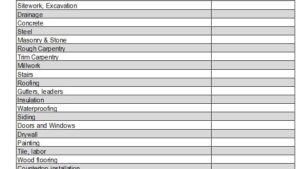For most construction projects, we send out our drawings and specifications along with a bid form to 4 or 5 builders. The bid form is a chart that helps itemize costs in line by line format so we can understand the various trades like electrical, plumbing, tile, framing etc. and compare them to each-other. This allows us to see if a bidder is too high or low in a certain trade and understand the reason. It’s not to “squeeze” the bidder into submission or get their sub-contractor to “sharpen their pencil if their really interested”…please. We want the bidders to make a fair profit and do a good job . That’s the win-win. Happy client-Happy builder.
We know that the 25 lines in our bid form lack the detail to get all the nuances of each trade, but we also want to make it user friendly so the contractors avoid the “bottom line number” with no explanation or back-up” . We disqualify them from our bidding. The bidding breakdown helps us analyze if there was a misunderstanding in the drawings or bid or perhaps something was missing-and the bid is artificially low. This can present future problems when a contractor seeks to make up for missing costs through bogus change-orders or other shenanigans.
https://seconarchitect.com/your-guys-my-guys-those-guys-who-is-going-to-build-your-project/
In an effort to remain competitive, many bidders will submit bids that omit portions of the work or substitute materials that they feel are equal to what has been specified. When omissions or substitutions in the bid have been provided, it must to be called out as such in the bid or we cannot compare “apples to apples”.

Lowest Bidder or Highest Risk?
We get back the bids, analyze them and try to evaluate why the prices ended up at these prices. There are many factors + or – that go into the bids:
How hungry is the builder? +
How much competition is there? +
Are there material or labor shortages? –
Is the project located among other projects they are building? +
Can the builder leverage this project in order to get others? +
Did the builder misunderstand the drawings? –
Are the subcontractors too busy? –
Are the substitutions or any deviations from the drawings and specifications?
You get the idea.
We frequently discuss the bids with the bidders and ask questions to more clearly understand the background in their development. Also we’ll review opportunities to negotiate and help our clients get a better price or value without jeopardizing quality or schedule. It can be tricky – too much pressure and viola! you get the chef who spits in your soup because you squeezed too hard.
A proper balance has to be achieved to incentivize/pay the builder to want to be at your project and fully commit without over-reaching too aggressively.
We’ve done it for hundreds of projects both little and huge. Let’s talk, we have a few solid strategies we love to share with you…ask for Steve 914 980 5532



